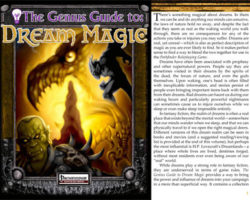The Genius Guide to Dream Magic by Owen K.C. Stephens is a role playing game supplement published by Rogue Genius Games (originally as Super Genius Games) for use with the Pathfinder Roleplaying Game. As such, it is covered by the Open Game License and some parts are considered to be Open Game Content as a result. This supplement covers the concept of dream magic.
The supplement is available from RPGNow at the regular price of $3.99 but was bought at the greatly reduced price of $0.20 as part of a special bundle. This is a sixteen page PDF with two thirds of a page being the front cover and one page being the Credits and Open Game License.
 It starts with a consideration of dreams, including as related to prophesy and supernatural powers, and the common idea in fantasy fiction that the realm of dreams is an actual real place. Naturally, this section mentions H. P. Lovecraft‘s Dreamlands, one of the most well known. The idea of the supplement is to bring dream magic into a campaign.
It starts with a consideration of dreams, including as related to prophesy and supernatural powers, and the common idea in fantasy fiction that the realm of dreams is an actual real place. Naturally, this section mentions H. P. Lovecraft‘s Dreamlands, one of the most well known. The idea of the supplement is to bring dream magic into a campaign.
The first section is The Dreaming Descriptor, a new descriptor for spells. The spell dream from the Core Rulebook should be considered to have this descriptor for the designated messenger. Dream descriptor spells only affect those creatures that sleep and dream.
The Dreamscape is a demiplane connected to dreams. Ordinary dreamers can enter the realm, which is usually safe in the real world no matter what happens to their dreaming body. Usually safe, not always; there are exceptions. Also in this section are the effects of the Dreamscape, how to travel to, and from, it and the creatures who inhabit it.
Next up are New Spells. There are a number of dreaming and sleep-related spells, that cover a range of effects, such as dream guardians, means of communication, the ability to travel through dreams, find objects and enjoy a peaceful sleep.
There are New Options, the Sleep Domain for clerics, the Dreamscape Bloodline for sorcerers and the Nightmare Specialist for wizards.
Finally, there are creatures. These are not specific creatures, but the Dreamlander Template for existing ones, and the Nocnista, a rather more dangerous addition to the template. Nocnista can draw sleepers into the Dreamscape against their will, and actually harm them.
The last section is suggested reading and viewing sources of inspiration.
The Genius Guide to Dream Magic in Review
The PDF lacks bookmarks and, despite being short, these would have been useful. Navigation is substandard.
The text maintains Super Genius Games’ old three column landscape format, and is almost error free. The landscape format is intended to be easier to read on tablets and screens, and this is true for larger screens but not so much for smaller ones. It is also inconvenient to print. There are a few colour images in different styles, all of which appear to be stock as none appear hugely relevant to the material. Presentation is adequate.
The idea of the supplement itself is interesting, and there is a fair bit of information provided. A new plane, new creatures, new spells and new abilities. All add an interesting element of dream magic to a game. If there’s one real problem – and truthfully it isn’t a problem but a desire for more – it is that the supplement could have been even more. More creatures, more spells, more magic items, a fuller description of the Dreamscape, dream deities and so on. The ideas here could perhaps have been expanded out into a much, much larger (and admittedly more expensive) supplement. What it does have is good; there simply are possibilities to expand it so much more. Which is not truly a complaint but a wish.
This is an excellent little supplement on adding dream-based magic and material to a game, and a GM could always expand it more themselves. The Genius Guide to Dream Magic can be found by clicking here.

Leave a Reply